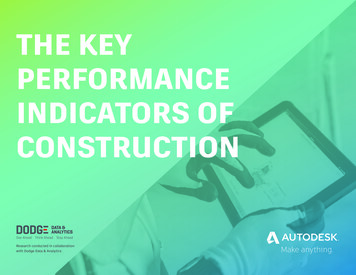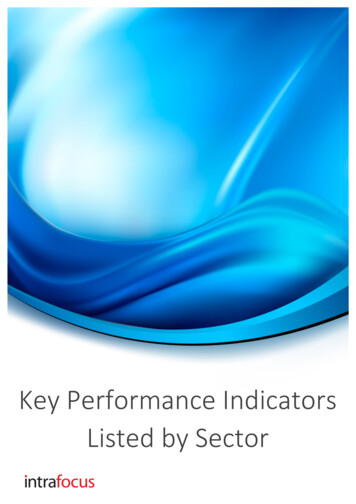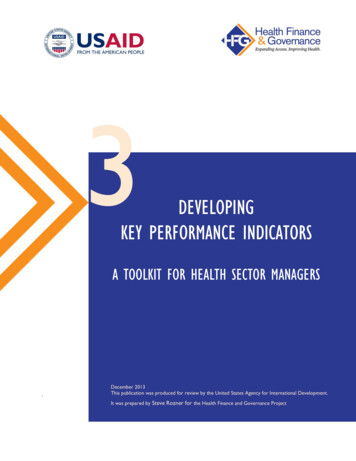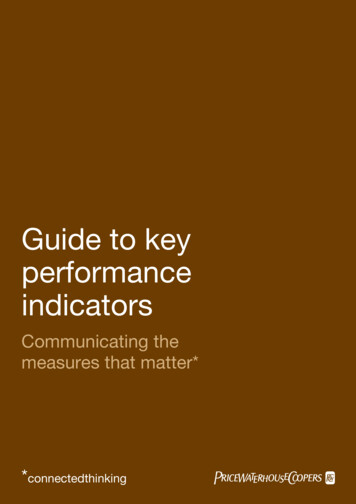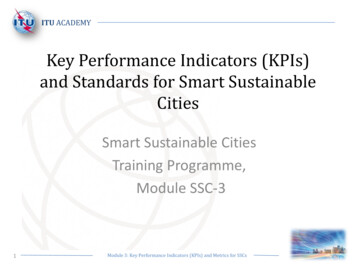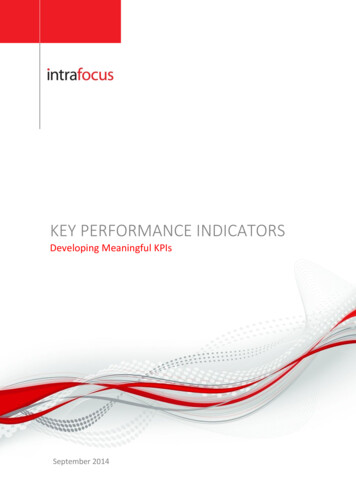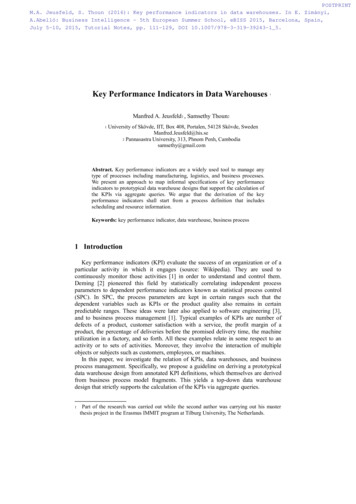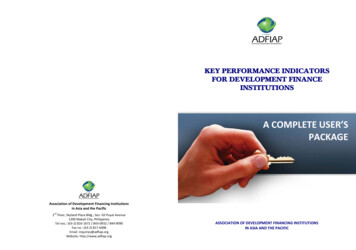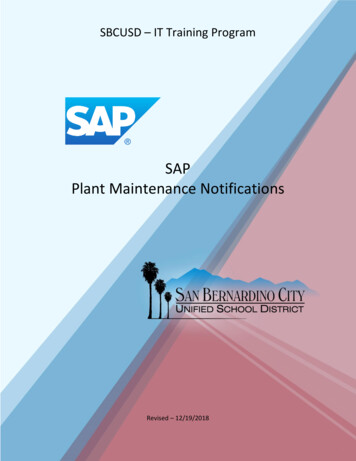
Transcription
KEY PERFORMANCEINDICATORSMeasuring and Managing the MaintenanceFunctionNovember 2005Written by:Al WeberReliability Consultant, IvaraRon ThomasDirector of Reliability Practices, DofascoIVARA CORPORATION935 Sheldon Court,Burlington Ontario. Canada. L7L 5K6Confidential information of Ivara Corporation. Ivara is a registered trademark of Ivara Corporation.Not to be copied, disclosed or electronically distributed without written permission from Ivara.
Copyright 2005 Ivara Corporation. All rights reserved.Information in this document is confidential.No part of this document may be reproduced, stored ina retrieval system or transmitted in any form or anymeans electronic or mechanical, includingphotocopying for any purpose other than as agreedwithout permission ofIvara Corporation.Ivara Corporation935 Sheldon CourtBurlington, OntarioCanada. L7L 5K6Toll free: 1-877-746-3787Tel: 905-632-8000Fax: 905-632-5129www.ivara.comConfidential information of Ivara Corporation. Ivara is a registered trademark of Ivara Corporation.Not to be copied, disclosed or electronically distributed without written permission from Ivara.
Maintenance Key PerformanceIndicatorsIntroduction“It is not possible to manage what you cannotcontrol and you cannot control what you cannotmeasure!” (Peter Drucker)Performance measurement is a fundamentalprinciple of management. The measurementof performance is important because itidentifies current performance gaps betweencurrent and desired performance andprovides indication of progress towardsclosing the gaps. Carefully selected keyperformance indicators identify preciselywhere to take action to improveperformance.This paper deals with the identification ofkey performance indicators for themaintenance function, by first looking at theways that maintenance performance metricsrelate to manufacturing metrics.Sinceperformancemeasurementsformaintenance must include both resultsmetrics and metrics for the process thatproduces the results, this documentpresents a representation for the businessprocess for maintenance. The documentthen identifies typical business process andresults metrics that can be used as keyperformance indicators for the maintenancefunction.customer service, operating costs, safetyand environmental integrity.To achieve this performance there are threeinputs to be managed. The first requirementis Design Practices. Design practicesprovide capable equipment "by design"(inherentcapability),tomeetthemanufacturing performance requirements.The second requirement is OperatingPractices that make use of the inherentcapability of process equipment. Thedocumentation of standard operatingpractices assures the consistent and correctoperation of equipment to maximizeperformance.The third requirement is MaintenancePractices that maintain the inherentcapability of the equipment. Deteriorationbegins to take place as soon as equipmentis commissioned. In addition to normal wearand deterioration, other failures may alsooccur. This happens when equipment ispushed beyond the limitations of its designor operational errors occur. Degradation inequipment condition results in reducedequipment capability. Equipment downtime,quality problems or the potential foraccidents and/or environmental excursionsare the visible outcome. All of these cannegatively impact operating cost.Physical Asset ManagementThe purpose of most equipment inmanufacturing is to support the production ofproduct destined to downstream customers.Ultimately the focus is on meeting customerneeds. This is illustrated in Figure 1.Customer expectations are normally definedin terms of product quality, on-time deliveryand competitive pricing. By reviewing thecomposite requirements of all currentcustomers and potential customers in thosemarkets we wish to penetrate, theperformance requirements of our physicalassets can be defined. dwithquality,availability,Figure 1: Managing manufacturing performancerequirements to meet customer needsManufacturing key performance indicatorsprovide information on the current state ofmanufacturing. Asset capability, operatingConfidential information of Ivara Corporation. Ivara is a registered trademark of Ivara Corporation.Not to be copied, disclosed or electronically distributed without written permission from Ivara.Page 3 of 16
practices and the maintenance of assetcondition all contribute to the ability to meetthese performance requirements.Some typical key performance indicators formanufacturing include operating cost; assetavailability, lost time injuries, number ofenvironmental incidents, OEE and assetutilization.Consider asset utilization, as depicted inFigure 2. Asset utilization is a manufacturinglevel key performance indicator. It is afunction of many variables. For example,asset utilization is impacted by bothmaintenance and non-maintenance relateddowntime.Non-maintenancerelateddowntime may be attributed to lack ofdemand, an interruption in raw materialsupply or production scheduling delaysbeyond the control of the maintenancefunction. Asset utilization is also a functionof operating rate, quality and yield losses,etc. In each of these areas maintenancemay be a factor but it is not the onlycontributor. In order to maintain and improveperformanceeachfunctionintheorganization must focus on the portion of theindicators that they ance indicators are not only afunction of maintenance. They are affectedby causes beyond the control of themaintenance function. Asset capability,operating practices and the maintenance ofasset condition all contribute to the ability tomeet performance requirements. If amanufacturing level indicator is used tomeasuremaintenanceperformance,improved maintenance may not result in aproportionalimprovementinthemanufacturing metric. For instance, in theasset utilization example, cited above, themaintenance contributors may all be positiveand yet the resulting asset utilization maynot improve due to other causes.A key principle of performance managementis to measure what you can manage. Inordertomaintainandimprovemanufacturing performance each function inthe organization must focus on the portion oftheindicatorsthat theyinfluence.Maintenance performance contributes tomanufacturing performance. The keyperformance indicators for maintenance arechildrenofthemanufacturingkeyperformance indicators.Figure 2: Asset Utilization is an example of amanufacturing level key performance indicator.Key performance indicators for maintenanceare selected ensuring a direct correlationbetween the maintenance activity and thekey performance indicator measuring it.When defining a key performance indicatorfor maintenance a good test of the metricvalidity is to seek an affirmative response tothe question; “If the maintenance functiondoes ‘everything right’, will the suggestedmetric always reflect a result proportional tothe change; or are there other factors,external to maintenance, that could maskthe improvement?”This paper focuses on defining keyperformance indicators for the maintenancefunction, not the maintenance organization.Confidential information of Ivara Corporation. Ivara is a registered trademark of Ivara Corporation.Not to be copied, disclosed or electronically distributed without written permission from Ivara.Page 4 of 16
Figure 3: The Asset Reliability Process identifies what's required to manage the maintenance function.The maintenance function can involve otherdepartments beyond the maintenanceorganization. Similarly, the maintenancedepartment has added responsibilitiesbeyond the maintenance function and, assuch, will have additional key performanceindicators to report. The key performanceindicators for the maintenance organizationmay include key performance indicators forother areas of accountability such as healthandsafetyperformance,employeeperformance management, training anddevelopment, etc.The Asset Reliability ProcessThe management of physical assetperformance is integral to business success.What we manage are the businessprocesses required to produce results. Oneof these business processes is responsiblefor the maintenance of physical assetreliability. The Asset Reliability Process isshown in Figure 3. It is an integral part of amuch larger business process responsiblefor managing the total enterprise.A proactive Asset Reliability Process,represented by the seven (7) elements inthe model aims to deliver the performancerequired by the enterprise to meet all of itscorporate objectives. Each element withinthe maintenance process is in itself a subprocess. A brief description of each elementfollows:Business Focus, represented by the greenbox on the left, focuses the maintenance ofphysical asset reliability on the businessgoals of the company. The potentialcontribution of the asset base to these goalsis evaluated. The largest contributors arerecognized as critical assets and specificperformance targets identified.Work Identification, as a process,produces technically based Asset ReliabilityPrograms. Program activities identify andcontrol failure modes impacting on theequipment's ability to perform the intendedfunction at the required performance level.Activities are evaluated to judge if they areworth doing based on the consequences offailure.Confidential information of Ivara Corporation. Ivara is a registered trademark of Ivara Corporation.Not to be copied, disclosed or electronically distributed without written permission from Ivara.Page 5 of 16
Planning develops procedures and workorders for these work activities. Theprocedures identify resource requirements,safety precautions and special workinstructions required to execute the work.Scheduling evaluates the availability of allresources required for work "due" in aspecified time frame. Often this workrequires the equipment to be shut down. Areview of production schedules is required.Resources are attached to a specific workschedule. The use of resources is balancedout.In the Execution process, trained,competent personnel carry out the requiredwork.The Follow-up process responds toinformation collected in the executionprocess. Work order completion commentsoutline what was done and what was found.Actual time and manpower, to complete thejob, is documented. Job status is updated ascomplete or incomplete. Corrective workrequests, resulting from the analysis ofinspection data, are created. Requests aremade for changes to drawings andprocedures.The process of Performance Analysisevaluatesmaintenanceprogrameffectiveness. Gaps between actual processperformance and the required performanceare identified. Historical maintenance data iscomparedtothecurrentprocessperformance. Maintenance activity costs arereviewed. Significant performance gaps areaddressedbyrevisitingtheWorkIdentification function.Each element is important to provide aneffective maintenance strategy. Omitting anyelement will result in poor equipmentperformance, increased maintenance costsor both.Forexample,WorkIdentificationsystematically identifies the Right Work tobe performed at the Right Time. Withoutproper Work Identification, maintenanceresources may be wasted. Unnecessary orincorrect work will be planned. Onceexecuted, this work may not achieve thedesired performance results, despitesignificant maintenance costs. WithoutPlanning the correct and efficient executionof the work is left to chance. The PlannedMaintenanceProcessisacycle.Maintenance work is targeted to achieverequiredassetperformance.Itseffectiveness is reviewed and improvementopportunities identified. This e impacted by Maintenance.Within the Planned Maintenance Processtwointernalloopsexist.Planning,Scheduling, Execution and Follow Up makeup the first loop. Once maintenanceactivities are initially identified, an assetmaintenance program, based on currentknowledge and requirements, is initiated.The selected maintenance activities will beenacted upon at the designed frequency andmaintenance tolerance limits. The process isself-sustaining.The second loop consists of the WorkIdentification and Performance p.Actualassetperformance is monitored relative to therequired performance (driven by businessneeds). Performance gaps are identified.The ‘cause’ of these gaps is established andcorrective action recommended.Performance Metrics for the MaintenanceFunctionThe Asset Reliability Process represents thecollection of ‘all’ tasks required to supportthe maintenance function. The process is asupply chain. If a step in the process isskipped, or performed at a substandardlevel, the process creates defects known asfailures. The output of a healthy reliabilityprocess is optimal asset reliability at optimalcost.Asset Reliability Process measures areleading indicators. They monitor if the tasksare being performed that will ‘lead toresults’. For example a leading processindicator would monitor if the planningfunction was taking place. If people areConfidential information of Ivara Corporation. Ivara is a registered trademark of Ivara Corporation.Not to be copied, disclosed or electronically distributed without written permission from Ivara.Page 6 of 16
doing all the right things then the results willfollow. The leading ‘process’ indicators aremore immediate than results measures.Result measures monitor the products of theAsset Reliability Process. Result measuresinclude maintenance cost (as a contributorto total operating cost), asset downtime dueto planned and unplanned maintenance (asa contributor to availability) and number offailures on assets (the measure of reliability:this can then be translated into mean timebetween failures). Results measures lag.Failure is a good example. Typically thesame piece of equipment doesn’t fail dayafter day. Take a pump for example. Say thepump fails on average once every 8 months.If we improve its reliabili
quality problems or the potential for accidents and/or environmental excursions are the visible outcome. All of these can negatively impact operating cost. Figure 1: Managing manufacturing performance requirements to meet customer needs Manufacturing key performance indicators provide information on the current state of manufacturing. Asset capability, operating . Confidential information of .
